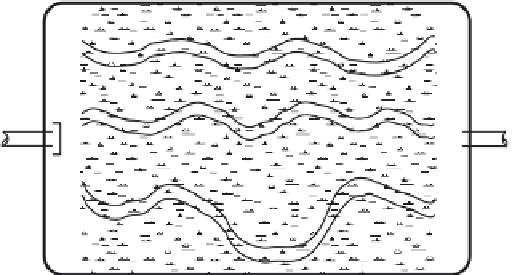Environmental Engineering Reference
In-Depth Information
After sizing a FWS wetland, it is highly recommended
that biogeochemical cycles in the wetland be reviewed
to ensure that they are able to support the assimilation
rates that are implicit in the sizing calculations. This
would typically involve reviewing the carbon, nitrogen,
and phosphorus cycles in the wetland (Kadlec and
Wallace, 2009). Evaluation of seasonal flow rates might
indicate wetland flows and characteristics during one
season (usually winter) yields extreme area require-
ments, and in such cases storage of the wetland inflow
(for release during the spring) might be the appropriate
practice. In cases where target effluent concentrations
are to be met with a high level of confidence, it might
be appropriate to assume that these target concentra-
tions are at the 90% confidence limit, and a reduction
factor applied to estimate the (lower) mean target con-
centration, and this lower concentration used in sizing
the wetland.
least two cells in parallel to allow for cell resting, rota-
tion of flows, and maintenance. Vegetation dieoff,
wetland contamination, and structural failures within a
wetland can require the shutdown of wetland cells. Ulti-
mately, the wetland must fit within the contours and
boundaries of the land that is available for wetland
development.
Preapplication Treatment.
Some form of preliminary
treatment usually precedes wetland treatment systems.
The required level of preapplication treatment depends
on the functional intent of the wetland, on the level of
public exposure expected, and on the need to protect
habitat values. The minimum preliminary treatment for
municipal wastewater would be the equivalent of
primary treatment, accomplished using septic tanks or
Imhoff tanks for small systems or pond units with deep
zones for sludge accumulation for large systems. Provid-
ing the equivalent of secondary treatment is considered
prudent before allowing public access to the wetland or
developing specific habitats that encourage birds
and other wildlife. This level of treatment can be
accomplished at a first-stage wetland unit where public
access is restricted and habitat values are minimized.
Tertiary treatment with nutrient removal may be neces-
sary before discharging to natural wetlands where
preservation of the existing habitat and ecosystem is
paramount.
8.3.2.3 Other Considerations.
Other less quantita-
tive variables that must be considered in wetland
design include basin morphology, chemical loading,
soil composition, vegetation, and postconstruction
management.
Location.
The ideal site for a constructed wetland is
near the water source for the wetland, and at an eleva-
tion that permits gravity flow to the wetland, between
the wetland cells, and to the final discharge point. The
site should be available at a reasonable cost, should not
require extensive clearing or earthwork for construc-
tion, should have a deep nonsensitive groundwater
table, and contain subsoils that provide a suitable liner
when compacted.
Basin Morphology.
Several aspects of the morphology
of constructed wetland basins need to be considered
when designing wetlands. A typical wetland design is
shown in Figure 8.15. Constructed treatment wetland
designs should avoid rigid structures and straight chan-
nels whenever possible. A low-slope littoral zone pro-
vides an area of appropriate water depth for emergent
plants, thus allowing more wetland plants to develop
more quickly and stimulating wider variety of plant
Configuration.
Large wetlands are commonly divided
into
wetland cells
that function as individual smaller
wetlands. Ideally, treatment wetlands should have at
low-flow channel
deep pool
wetland
deep pool
berm
baffle
inflow
outflow
Figure 8.15.
Typical wetland design.











Search WWH ::

Custom Search